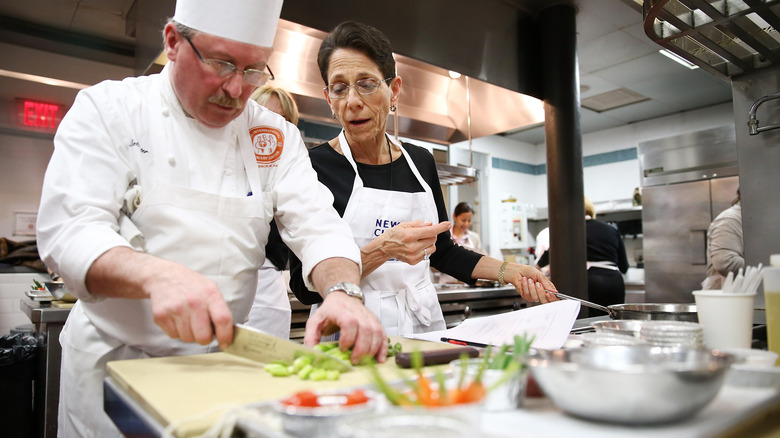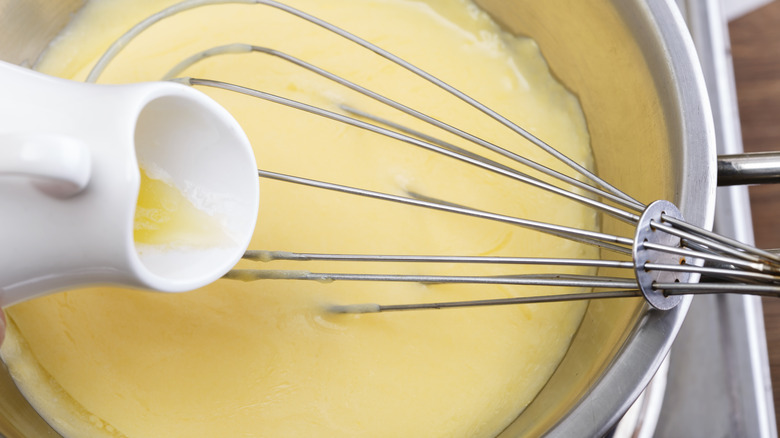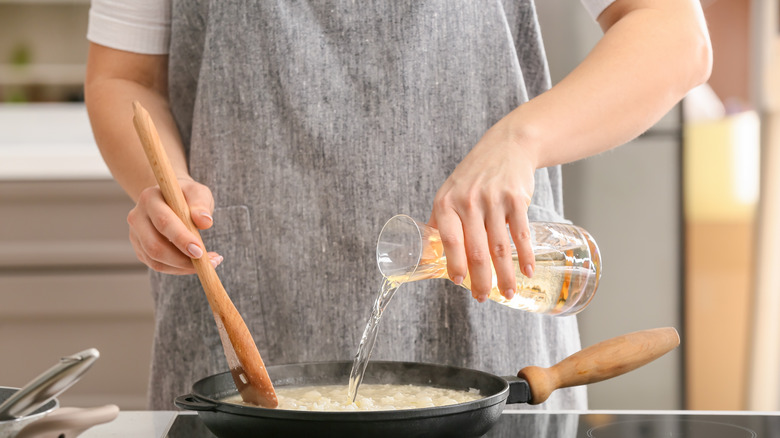The Types Of Culinary Ratios You Might Encounter In The Kitchen
If you've ever watched a cooking competition show like "Top Chef," it can seem like the contestants are making culinary magic happen out of nowhere. Where are the cookbooks and recipes? The answer is that good chefs have memorized a ton of cooking ratios for sauces, starches, and baked goods, which guide their dish's way from the pantry to the plate.
Chefs know that many of the basic recipes for things like pasta, rice, stock, and cookies all have basic compositions that can be broken down into ratios by weight or volume, or a combination of both, according to The Culinary Pro. And the nice thing about ratios is that they are much easier to remember than a list of individual ingredients in a recipe, plus they are also easier to scale up or down. For example, long-grain white rice is made with a 2-to-1 ratio of liquid to rice. Whether you're cooking 1 cup of dry rice or 1 quart of rice, all you need to know is that you need twice the amount of liquid for whatever your original measure of dry rice was. In fact you don't even need a measuring cup — if you use a coffee cup to measure your rice, you'd just use two of the same size coffee cup of water.
Common ratios
In commercial kitchens, recipes and ratios are important for consistency. Chef Eli Kirshtein explains for Top Chef that, "Without consistency, there is little to no hope to having a quality and successful restaurant." Customers should expect to get the same amazing meal every time they come to eat at a restaurant, and you can achieve the same consistency at home if you brush up on your ratios.
Some of the most common ratios are for a roux, which is the flour and fat base for a white sauce — the ratio is 1-to-1 flour to fat. Vinaigrettes are 3 parts oil to 1 part vinegar; Hollandaise sauce is made with six egg yolks for every pound of butter; pasta dough is 3 parts flour to 2 parts egg; bread is 5 parts flour to 3 parts water (per NPR), and cookies are often 3 parts flour to 2 parts fat and 1 part sugar (per Food Network). Any common recipe probably has a ratio, like stocks, which are generally 3 parts water to 2 parts bones, according to Cleveland.com.
Simple syrup, the liquid bartenders can't live without, is another easy 1-to-1 ratio of white sugar and boiling water. Cocktails in general are also often a ratio — 2 parts spirit, 1 part sweet, and 1 part sour, which is called "the golden ratio" (per Food & Wine).
Make your own ratios
In addition to all the common ratios you'll find in recipes and cookbooks, you'll probably also come across a few that are part of your family's personal recipe collection. This is how your grandma was able to whip up a loaf of bread without ever reading a recipe. Your uncle's perfect meatloaf, for example, might be 3 eggs and 1/2 cup of breadcrumbs for every 1 pound of meat, or your mom's pie dough is 3-to-2-to-1 — that is, 3 parts flour, 2 parts fat, one part water (per NPR).
If you want to play around with ratios at home, think of them as scientific formulas. Weight is the most accurate form of measure (as long as you have a kitchen scale), and the ratio should only include the main ingredients of whatever you're making (according to The Culinary Pro). For example, if you like making mushroom risotto, the ratio is anywhere from 3-to-1 to 4-to-1 liquid to rice, depending on how tender you like your rice. You would only include the rice and liquid in your ratio, and then add mushrooms and herbs to taste. Sainsbury's Magazine recommends around 60 grams of arborio rice per person, so you'll need around 180 grams of liquid if you're using a 3-to-1 ratio. Once you get the hang of cooking with ratios down, you can start looking at all recipes with an eye for it, and start cooking a lot more like a chef.


